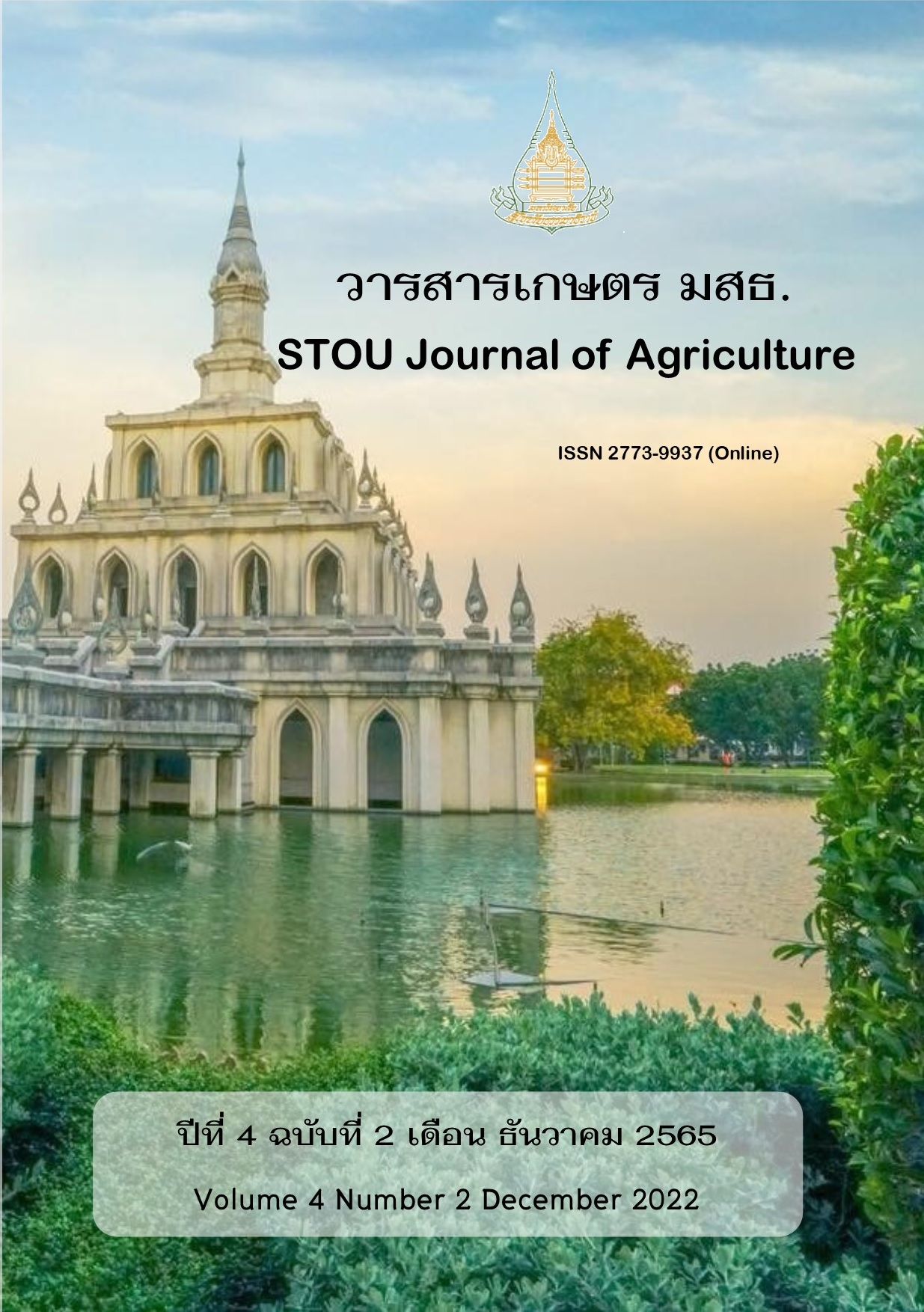ผลของการใช้หญ้าหวานเป็นวัตถุดิบอาหารข้นต่อสมรรถภาพการผลิตแพะเนื้อลูกผสมพันธุ์บอร์
Main Article Content
บทคัดย่อ
การทดลองนี้เพื่อศึกษาการใช้หญ้าหวานเป็นวัตถุดิบในการผสมอาหารข้นต่อสมรรถภาพการผลิต ต้นทุน และผลกำไรของการเลี้ยงแพะเนื้อลูกผสมพันธุ์บอร์ วางแผนการการทดลองแบบสุ่มสมบูรณ์ โดยใช้แพะเพศผู้น้ำหนักเฉลี่ย 19.00±1.00 กิโลกรัม/ตัว จำนวน 9 ตัว อายุ 3±1 เดือน แบ่งแพะออกเป็น3 กลุ่มๆ ละ 3 ตัว ได้แก่ กลุ่มที่ 1 ได้รับอาหารข้นสูตรทางการค้า (โปรตีนไม่น้อยกว่า 14 %) กลุ่มที่ 2 ได้รับอาหารข้นสูตรที่มีหญ้าหวาน 10% เปอร์เซ็นต์ และกลุ่มที่ 3 ได้รับอาหารข้นสูตรที่มีหญ้าหวาน 15% เปอร์เซ็นต์ แพะแต่ละกลุ่มจะได้รับอาหารข้น 2% ของน้ำหนักตัวและหญ้าเนเปียร์ปากช่อง 1 สับแบบเต็มที่ (ad libitum) ใช้ระยะเวลาในทดลอง 90 วัน ผลการทดลอง พบว่า ปริมาณการกินได้ของวัตถุแห้งรวม อัตราการเจริญเติบโต น้ำหนักตัวเมื่อสิ้นสุดการทดลอง และประสิทธิภาพการใช้อาหาร ความเข้มข้นของยูเรียไนโตรเจนและกลูโคสในกระแสเลือดหลังกินอาหารที่ 4 ชั่วโมง ไม่มีความแตกต่างกันทางสถิติ(P>0.05) ต้นทุนค่าอาหารและต้นทุนรวมของแพะกลุ่มที่ 1 มีค่าสูงกว่ากลุ่มที่ 2 และ 3 และเมื่อสิ้นสุดการทดลองแพะกลุ่มที่ 2 จำหน่ายได้ราคามากกว่าจึงทำให้ผลกำไรสุทธิสูงกว่าแพะกลุ่มที่ 1 และ 3 จึงเห็นได้ว่าการใช้หญ้าหวาน ในสูตรอาหารข้น 10 เปอร์เซ็นต์ สามารถนำมาใช้เป็นวัตถุดิบในการผสมอาหารแพะเนื้อที่สามารถลดต้นทุนค่าอาหารได้
Article Details

This work is licensed under a Creative Commons Attribution-NonCommercial-NoDerivatives 4.0 International License.
บทความที่ได้รับการตีพิมพ์เป็นลิขสิทธฺ์ของวารสารเกษตร มสธ.
ข้อความที่ปรากฎใน
References
กนกวรรณ แสงทอง, ปิตุนาถ หนูเสน และ วันวิศาข์ งามผ่องใส. (2565). ผลของระดับโปรตีนในอาหารข้นต่อสมรรถภาพการเจริญเติบโตและการใช้ประโยชน์ได้ของ โภชนะของแพะพื้นเมืองไทยเพศผู้. แก่นเกษตร 50 ฉบับที่ 2: 448-459
เชาวฤทธิ์ มาปะโท และ เมธา วรรณพัฒน์. (2560). หญ้าหวาน (Pennisetum purpurem cv. Mahasarakham) หญ้าหวานทางเลือกใหม่สำหรับสัตว์เคี้ยวเอื้อง. วารสารโคนม, 34(2), 57-63.
วนิดา มากศิริ, นงนุช รุ่มรวย, ลักษิกา นาชะนาง, สุนัฏฐา เกตุย้อย และเจนจินา แต้มเรืองอิทธิ์. (2563). การศึกษาการเจริญเติบโต ผลผลิต และองค์ประกอบทางเคมีของหญ้าหวานที่ปลูกในสภาพชุดดินเพชรบุรี. ใน การประชุมวิชาการวิทยาศาสตร์และเทคโนโลยีระดับปริญญาตรี ครั้งที่ 6 กลุ่มวิทยาศาสตร์ชีวภาพและเกษตร วันที่ 20 สิงหาคม 2563 ณ มหาวิทยาลัยราชภัฏพระนครศรีอยุธยา.
สำนักพัฒนอาหารสัตว์ (2559) คู่มือการแนะนำการให้อาหารแพะเนื้อ. กลุ่มวิจัยและพัฒนาอาหารสัตว์ สำนักพัฒนาอาหารสัตว์ กรมปศุสัตว์.
AOAC, (2000). Official Method of Analysis of AOAC International. 17th ed. The Association of Official Analytical Chemists, Virginia.
Henry, R.J., C.C. Donald and W.W. James. (1974). Clinical Chemistry: Principle and Technique. 2nd ed., Harper and Row Inc., Vergenia, USA.
Lazzaro, J. (2005). Normal blood chemistry values for adult goats. Available: http://www.saanendoah.com /bloodvalues.html, March 19, 2021.
Minson, D.J. (1984). Effect of chemical and physical composition of herbage eaten upon intake. In Hacker, JB (Ed.) Nutrition limits to animal production from pasture. Farnham Royal: CAB. P.167-182.
NRC. (1981). Nutrient Requirements of Goat: Angora, Dairy and Meat Goats in Temperate and Tropical Countries. National Academy Press, Washington D.C.
Tiffany, T.O., J.M. Jansen, C.A. Burtis, J.B. Overton and C.D. Scott. (1972). Enzymatic kinetic rate and end point analyses of substrate by the use of a GeMSAEC fast analyser. Clinical Chemistry.18: 829-840.
Schneider, B.H. and W.P. Flatt. (1975). The Evaluation of Feeding Through Digestibility Experiments. P. 169 Univ. Georgia Press, Athens.
Van Soest, P.J., Robertson, J.B., and Lewis, B.A. (1991). Methods for dietary fiber, neutral detergent fiber and non starch polysaccharides in relation to animal production. Journal of Dairy Science. 74 : 3583-3597.

